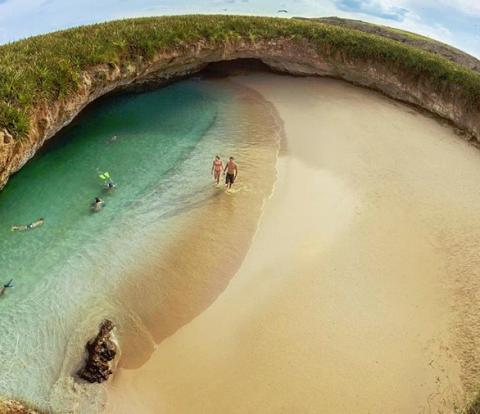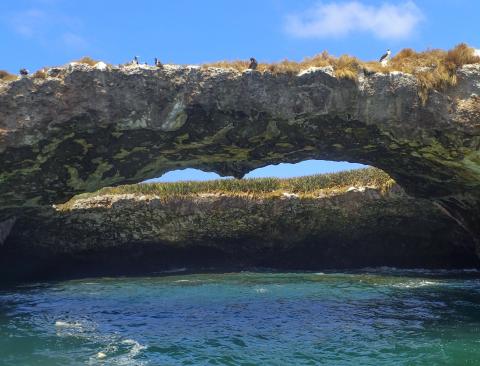Summer visitation in our parks is off to a big start, more than likely due to the increased marketing, editorial coverage, and interest during the National Park Service's centennial celebration. This has also lead to some crowding issues and stressed infrastructure. But this not strictly an American phenomenon. When you invite people into paradise, you must make sure that paradise doesn't lose out. Lately, this has been the case in one of Mexico's most popular parks: Islas Marietas, near Puerta Vallarta.
Puerta Vallarta is the sixth largest city in the state of Jalisco in Mexico, at a quarter million people. Add to that tens of thousands of vacationers every year, and it's no wonder that hotels and condominium projects are sprouting nearly everywhere along the coast.
A few weeks ago I had a chance to fly into this historic city, but caught a city bus north, munching on a smoked marlin burrito, heading to the small fishing village of Punta de Mita. The headland takes the same name, and just a few miles offshore is the Islas Marietas National Park. It's also well known for the new luxury resorts built in recent years by Four Seasons, and St. Regis. But the fishing village is still, for now, quaint, the local food wonderful, with a few miles of cobble and sandy beach, and crystal clear water. But, to the west, the islands beckoned.
These two small islets only cover about 13 square kilometers, but are a wildlife haven. A national park since 2005, it's all about birds, fish, beaches, and caves. The green water is filled with thousands of species of tropical fish; it's like swimming in an aquarium. There's the King Angelfish, Panamic Sergeant Majors, Cortez Chubs, Giant Damselfish, Moorish Idol, and the Rainbow Wrasse. You'll see sea urchins, pufferfish, sea cucumbers, sea turtles, and jellyfish. During the winter months the humpback and gray whales migrate south from Alaska to give birth in the Bahia de Banderas (the sixth largest bay in the world). They, along with dolphins, sea turtles, rays, and octopus populate these warm waters.
There are over 90 species of migratory and native birds on these volcanic islands, including frigate birds, herons, egrets, pelicans, and brown boobies. But the star of the show is surely the blue-footed boobys, who as their name suggests, have brilliant blue webbed feet. While they range from the Gulf of California to Peru, the Galapagos Islands are home to over half of all breeding pairs, which is perhaps once reason the Islas Marietas are marketed as Mexico's Galapagos. (As a sidenote, when I visited the Channel Islands National Park off the California coast last fall, they two were referred to as the American Galapagos).
The birds and fish are protected from hunting and fishing, but this is also a paradise for a snorkel, kayak, or scuba gear. But you better have a boat handy: there's only one place you can set foot on the island legally, and that closed last month for rehabilitation: the Playa Escondida, or Secret Beach.
You may have seen a photograph of this pristine beach, beneath its circular skylight of stone. Swimmers access the sandy beach by swimming through a 200 meter tunnel, preferably at low tide. Once there swim, snorkel, and picnic. However, it's not really a secret anymore, and it's not really as pristine as the photographs show.
Over the Easter holiday in March, there were over 2,500 visitors per day; way too many for any sort of enjoyable experience. Power boats from Puerta Vallarta, and other towns, descend on the islands, leaving more than just memories, and taking more than just photographs. There are stories of snorkelers climbing aboard their boats with coral and sea fans, and trash is everywhere.
The National Commission of Protected Natural Areas (CONANP) manages 67 parks, including this one. In fact over ten percent of Mexico is set aside in parks. Islas Marietas has only been part of their system since 2005, forty years after famed oceanographer Jacques Cousteau intervened, advocating its protection as a unique and pristine ecosystem, but one that has seen other impacts, literally. In the early 1900s the islands were used as a gunnery and bombing range, and in fact the circular skylight over Playa Escondida is the result of an aerial bomb. If you look closely you can still see some of the damage from shells and bullets along the volcanic cliffs.
So, we talked to my friend Oso Negro at Punta de Mita's small harbor, and arranged a ride out to the islands for a tour. Captain Tomas has been fishing and guiding for over 15 years, and he expertly timed the breakers and swells as he exited the boat basin. Within 25 minutes we flashed our Marine Park entrance fee wristbands ($2.50 per person, purchased at the park office onshore) to the rangers monitoring boat traffic, and then jumped overboard, where we were soon swimming with the fishes.
Playa Escondida however was not on our itinerary; we knew that it had been closed by CONANP on May 9, overwhelmed but the daily onslaught of visitors. With dozens of competing tour operators, destination branding, and intense marketing, visitation here skyrocketed in the past few years.
In 2012 nearly 28,000 people visited this park, but by 2015 visitation was over 100,000, although CONANP's own Park Management Program states that the daily, maximum capacity is only 625 tourists. The beach will be closed for the next three months as they develop a new plan to manage the visitation, mitigate the extensive damage to the coral reefs, protect the resource, and do cleanup. But this is also big business, and locals like Captain Tomas is concerned that his job might be threatened by the closure, and some downturn in numbers of visitors is now occurring.
The big cleanup actually started on June 6. Tour operators, environmental groups, and local citizens are using their own boats, gas, and labor to pick up the accumulated trash and repair damage. Scuba divers will be cleaning the seabed as well.
And, according to the Rivera Nayarit Convention and Visitors Bureau, this will happen on a continuing basis, and hopefully the idea will spread to other threatened areas in the Bahia de Banderas, and beyond. So, with a bit of luck, you may be able to once again visit the Playa Escondida, watch the birds soar, see the whales breach, and smile at the dolphins playing. It's definitely a place worth protecting.






 Support Essential Coverage of Essential Places
Support Essential Coverage of Essential Places






